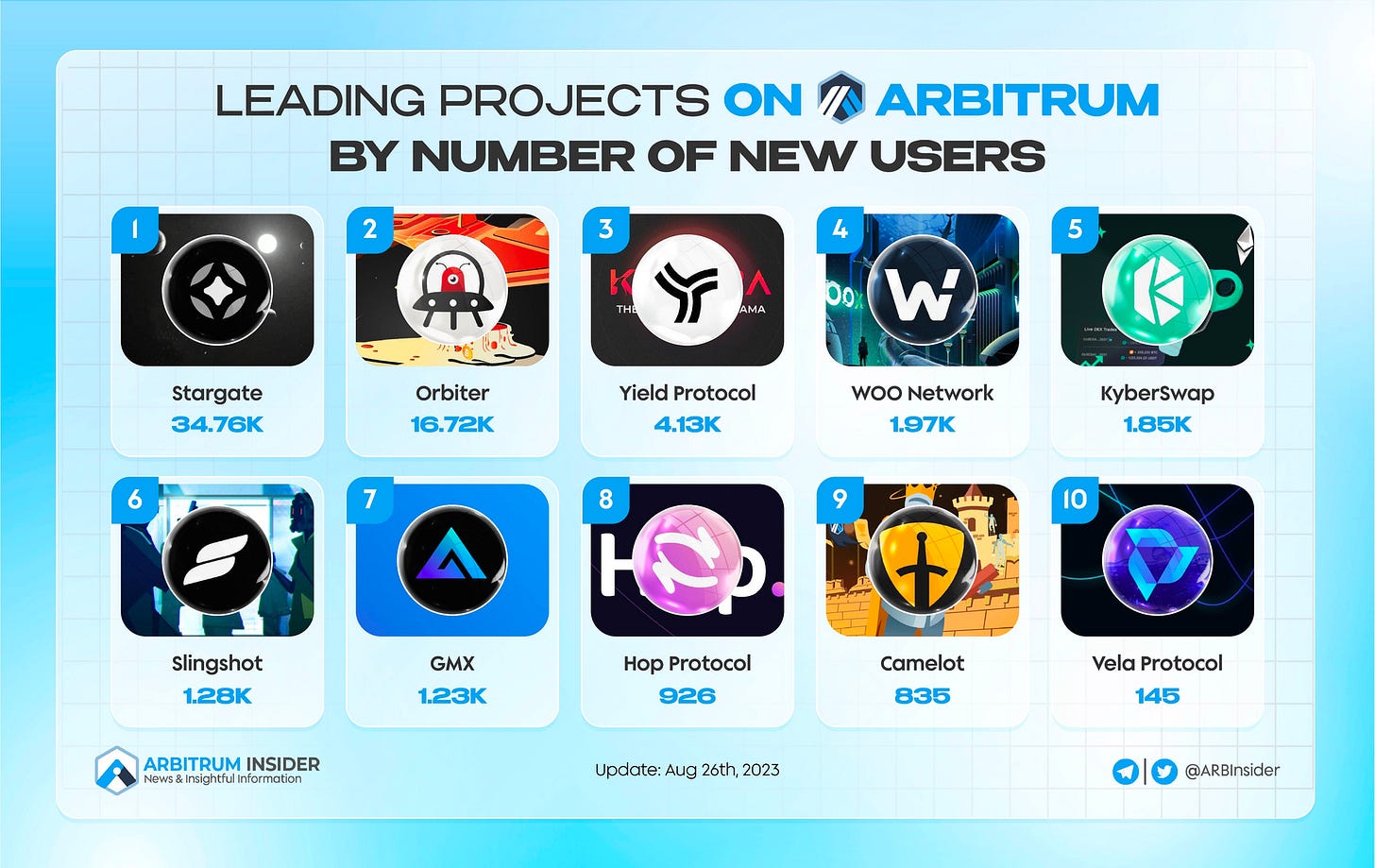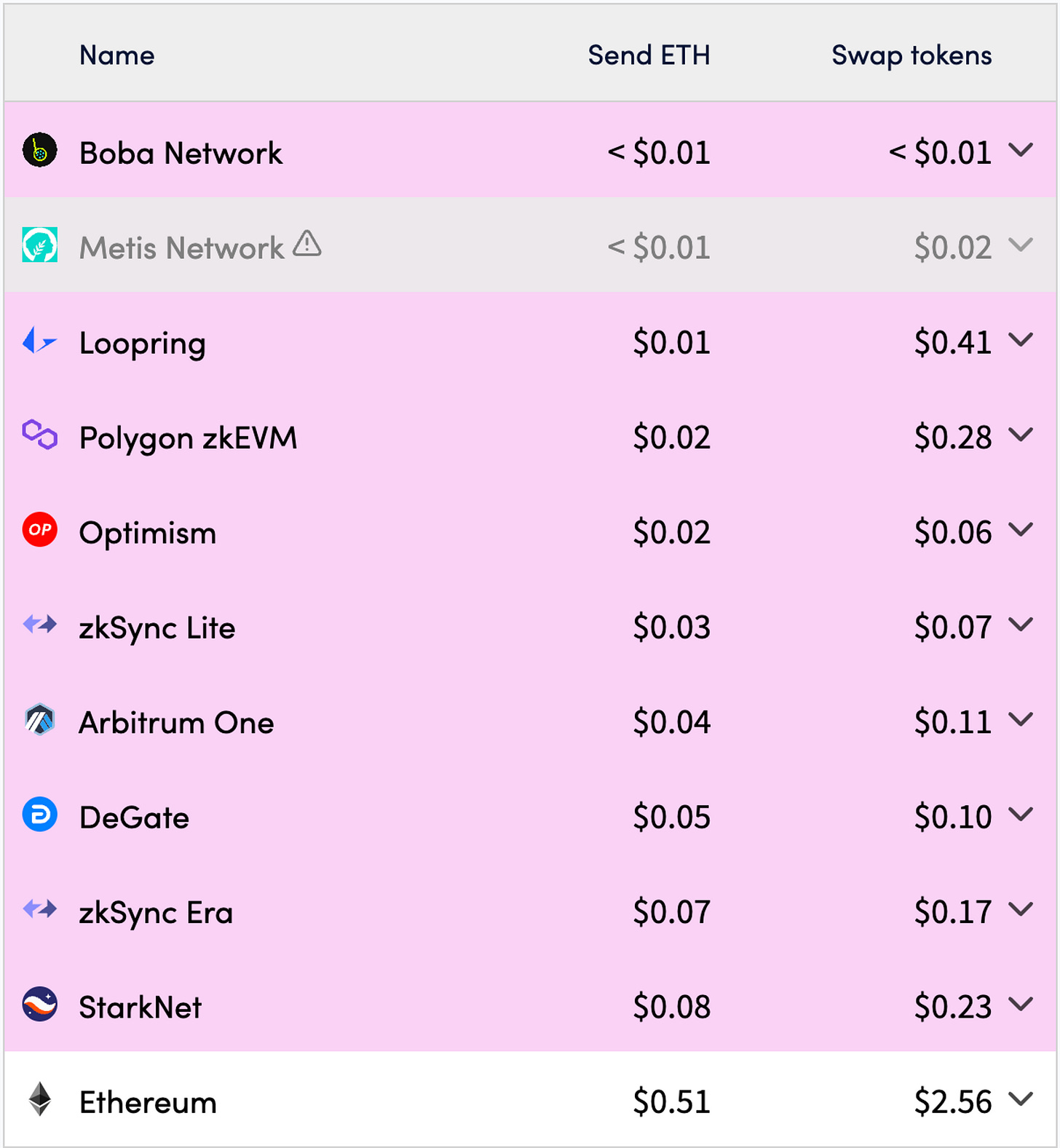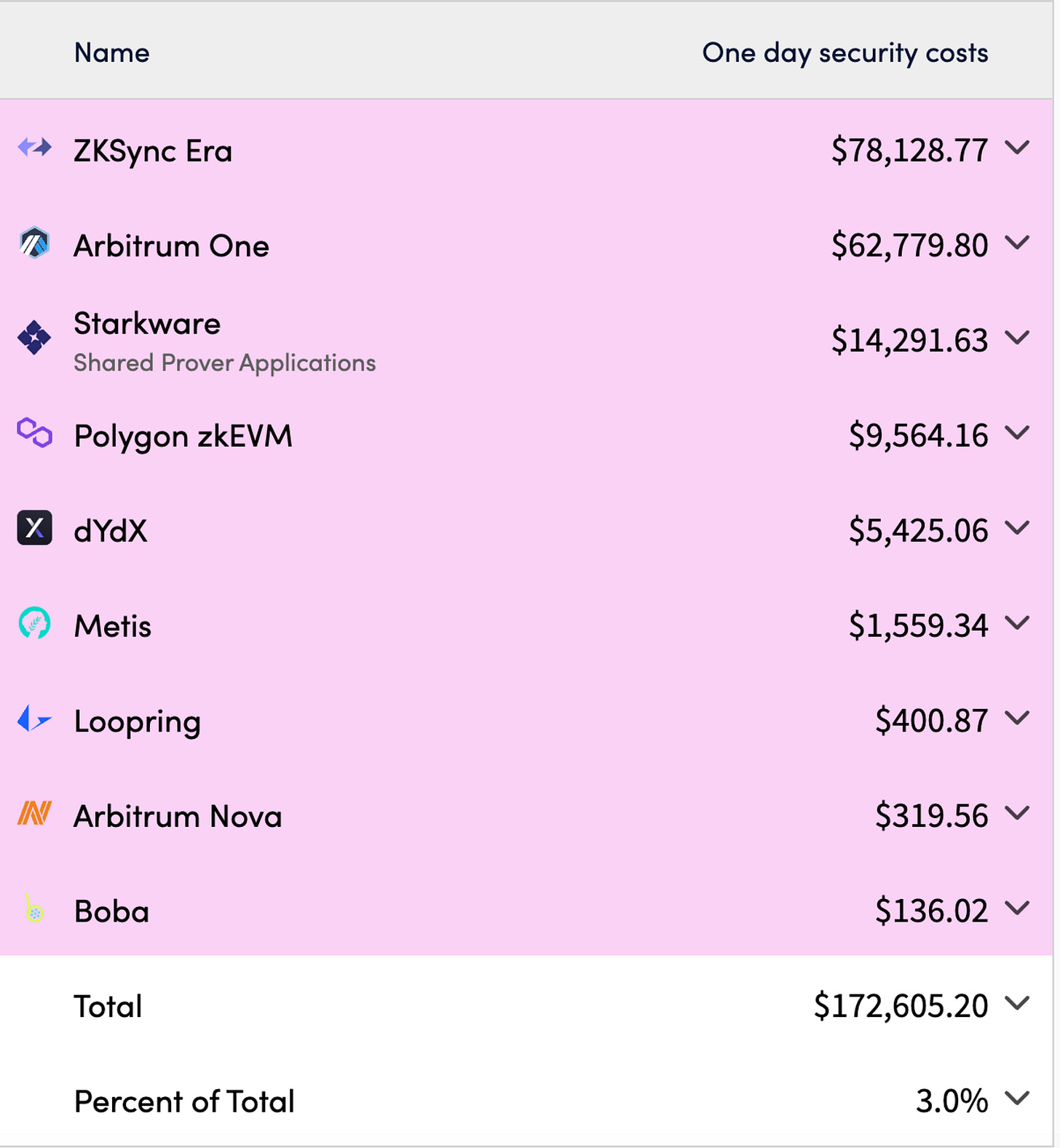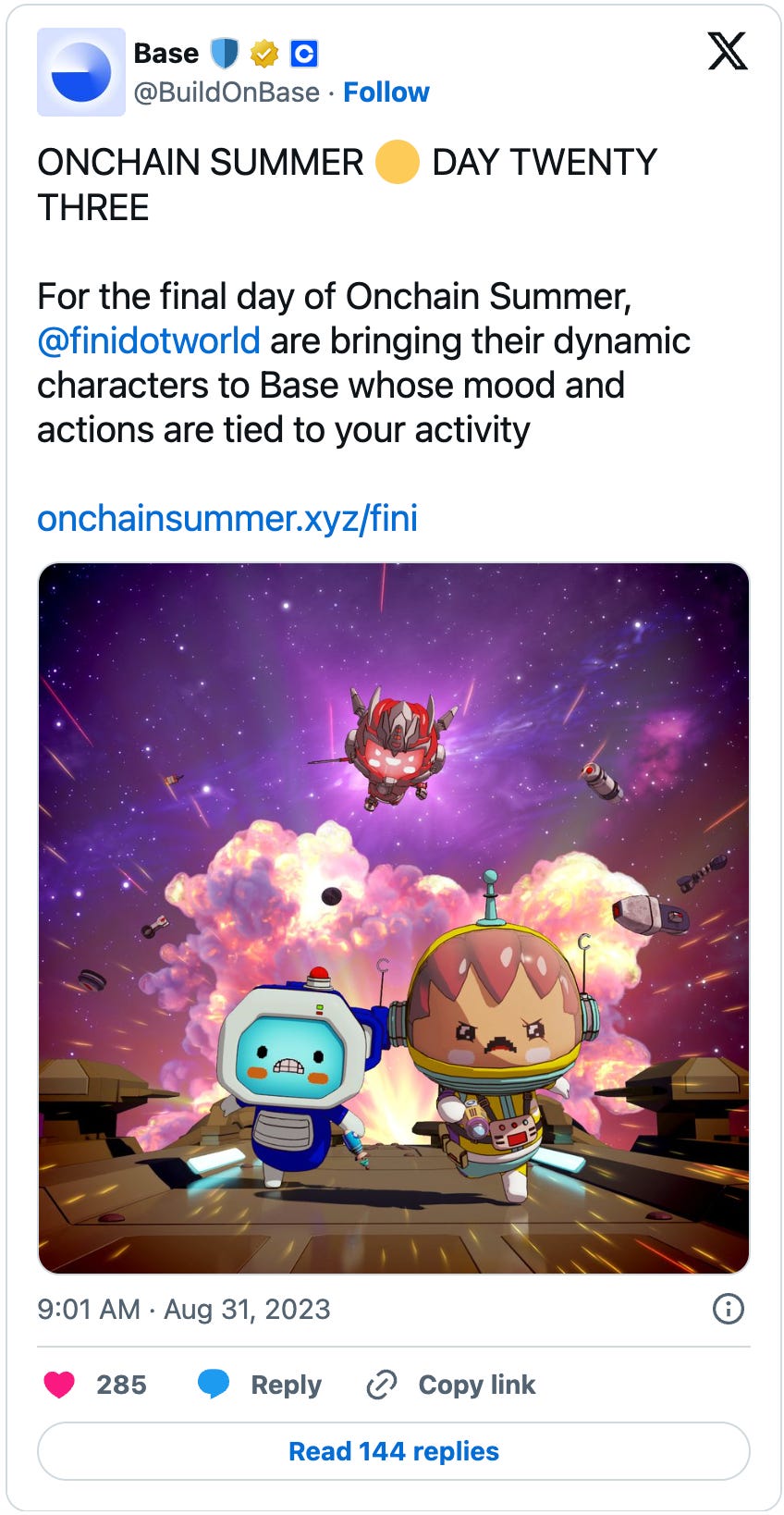OP Grants Stack: The Wellspring of Regenerative Cryptoeconomics | Layer 2 Review
Quick Reads and Hot Links Covering the People and Projects Who Are Scaling Ethereum
Dear Frens,
We shipped our last issue at the end of July, which seems waaaayyy too long ago, so we’re stoked to announce that starting with this issue, we’ll be shipping the Layer 2 Review fortnightly! Every two weeks you’ll have the quick reads and hot links you’ve come to love.
And let’s face it, with all the development around Layer 2s, we’ll need the additional issue per month. Just look at how August has been! Since we last shipped, we have been living in a Base(d) world, with Coinbase’s OP Stack-powered Layer 2 scaling solution dominating the space. And why wouldn’t it? With Onchain Summer in full swing, there wasn’t a more dynamic place to be than checking out all that’s happening on Ethereum’s newest playground.
The fun on Base began in late July with a pre-launch wonderland for degenerate shitcoiners. Friend.tech — a crypto-native social app that may be the SoFi vertical we’ve been waiting for — launched on Base three weeks later and hasn’t left the news since. Like it or hate it, friend.tech brought a lot of attention to Base. So even though today is the last day of official Onchain Summer, the action on Base is just getting started.
Because Base is built with the OP Stack, discussions are under way within the Optimism Collective around Base’s participation within the ecosystem, including token allocations and voting badges. With Base coming on board, now is a great time to get more familiar with not just the OP Tech Stack, but also the OP Grants Stack. For example, did you know that in addition to regular retroactive public goods funding rounds, the Optimism Collective has four types of proactive grants for work that moves the mission of the Collective forward. In this issue’s editorial, we’ll give you the TL;DR on the inner-workings of the Collective’s grant-giving earning opportunities. Stay strong, stay Based, and we hope you had a fantastic Onchain Summer. See you in two weeks frens.
Contributors: Warrior, jengajojo, Tonytad, thinkDecade, trewkat, HiroKennelly
This is an official newsletter of BanklessDAO. To unsubscribe, edit your settings.
✅ Action Items
🌀 Take a deep dive into Rollups are Real — Rollup Economics 2.0.
🗳️ Vote on the latest onchain Arbitrum vote to fix protocol mechanics.
🌶️ Spicy Takes
Starknet Upgrade Wipes Access to Funds, Later Restored
Solidity whiz foobar had something to say about Starknet:
And a few hours later:
🥶 Cold News
Zora’s Layer 2 Is Worth It
If you haven’t checked out Zora’s Layer 2, don’t wait any longer as the revamped Zora has amazing art, and a very clean interface to create ERC-721s and 1155s, including airdrops. Most surprising of all, it integrates with Nouns Builder to help creators build onchain organizations. And all of this with the low gas fees enabled by Optimism’s tech stack. Check out Zora, mint some art, create an NFT to drop and send it to your frens. Layer 2-enabled Zora empowers creators to do more of what they love: create.
🏛 Governance
⭐ Onchain Vote
AIP-7: Arbitrum One Governance Parameter Fixes
Three independent issues have been identified in the Arbitrum One Governance system that require immediate rectification:
Updating the airdrop distributor fee sweep address to the DAO Treasury’s address.
Sequencer gas fee reimbursement parameterization.
L1 Core Governance Timelock scheduleBatch Bug.
Following Forum discussion, the vote bypassed the regular Snapshot temp check and is now open for onchain voting.
💬 Proposals in Discussion
Arbitrum
September is Arbitrum #GovMonth! ARB token holders can help shape the future of Arbitrum DAO through working to scope its mission, vision, and values, decide where to allocate grants, and to help builders within the ecosystem. There’s 200k ARB up for grabs, so check out Arbitrum #GovMonth and see how you can get paid to govern!
Optimism
Base recently dropped a note on Optimism’s Forum discussing how it will contribute to the Collective and help fund public goods, but also soliciting feedback from the Collective on how Base can best participate in the Collective. Kudos Jesse Pollak. 👏
Starknet
Starknet is finally ready to move towards delegated governance! They’ve been collecting profiles since last December, but it’s not too late to become a delegate! If you’re interested in participating in Starknet governance, drop a note in the profile Forum post.
Celo
Another alt L1 moves to become a Layer 2 scaling solution. Let’s welcome Celo, a blockchain that’s been around for a long time and may contribute wonderful things to the Ethereum ecosystem. Check out the near 100% approval vote below:
🗳️ Polling Station
🪂 Airdrop Station
📈 Data
Total Value Locked on L2s Down Slightly to $9.6 billion!

Top Ten Projects by Total Value Locked:

🔭 Project Watch
Arbitrum
Top Projects by TVL

Trending NFT Collections

What Projects Are Users Flocking To?

Optimism
Top Projects by TVL

Trending NFT Collections

Top Projects by Interaction

Top Projects by New Users

zkSync
Top Projects by TVL

zkEVM
Top Projects by TVL

OP Grants Stack: The Wellspring of Regenerative Cryptoeconomics
Author: HiroKennelly
For the past few months, Bankless Publishing and several other teams across BanklessDAO have been working together to inform our audience about the core tenets anchoring the Optimism Collective, such as the Optimistic Vision and the Impact=Profit ethos.
For those who are just getting up to speed, the Collective is the name given to describe Optimism’s ecosystem, including users, contributors, builders, founders, projects, protocols, and capital. It’s not too much of a stretch to say the Collective's ultimate goal isn’t just to figure out how to sustainably fund public goods in web3, but how to solve some of the great coordination problems in fiat space too. Ambitious, of course, but not impossible.
The Collective is guided by the Optimism Foundation, in tandem with the Token and Citizens’ Houses. For more information on the formation of the Collective, you can check out this article I dropped shortly after Optimism tokenized.
The work being done at BanklessDAO is supported by a grant from the Collective, one of a number of initiatives funded to spread awareness of the Optimistic Vision. This is not the first time BanklessDAO projects have received funding for their Optimism-related work. In fact, several content production teams at the DAO have championed Optimism for well over a year, and have received retroactive grants related to that work.
The Collective’s third retroactive public goods round is happening soon and proactive grants are ongoing. Given that we’ve received both retroactive grants and proactive grants, we thought it’d be helpful to provide a brief overview of the Collective's grants programs.
Optimism Has Multiple Grants Funding Mechanisms
In terms of grants, Optimism is best known for retroactive public goods funding — the material manifestation of the Optimistic Vision, embodied by its core thesis: Impact=Profit. This is the idea that those who create value through public goods should be monetarily rewarded for these efforts.
But retroactive grants are not the only funding mechanism used by the Collective. In addition to funding work that has already contributed to the success of the network, the Collective also runs a comprehensive proactive grants program that pre-aligns grantees with various goals as prioritized by the Optimism Foundation.
In fact, there are four kinds of Collective Grants (discussed further below), but the most radical of these is called Collective Intents. This governance experiment by the Optimism Foundation is underway. In fact, it’s under Intent 3: Spread Awareness of the Optimistic Vision, that BanklessDAO (an Alliance) has sought and received support to create a Global Campaign to Spread the Optimistic Vision (the Mission).
Taken together, the two strands of the Optimism grants program create a model that both rewards those for the great work they’ve done to move the mission of the Collective forward, and incentivizes those within the Collective to contribute expertise to key priorities. Along the way, we all get to participate in a grand experimental playground to learn how best to collectively govern not only individuals and small teams, but large organizations and ecosystems.
Retroactive Public Goods Funding Is Impact=Profit
To understand how Optimism thinks about grant funding, you must internalize Impact=Profit, which simply means people who contribute value to the collective good (impact) should receive funding (profit) in proportion to the significance of their work.
We’ve written at some length about Optimism’s belief in retroactive public goods funding (RetroPGF) on Bankless Publishing and in the Layer 2 Review, but we’ve spent less time discussing how the process actually works. We’ll use RetroPGF Round 2 as an example, but let’s start at a high level.
Optimism has identified three core components of RetroPGF:
Impact scoping: what should the Collective fund? How is it defined and decided on?
Impact scoring: how does the Citizens’ House evaluate impact? What units, process, or tools do we use?
Impact settlement: how does voting work?
The Optimism Foundation currently defines both the scope of the RetroPGF round and how voting works, but over time it plans to cede that authority to the Collective. For now, the Citizens’ House allocates OP tokens within the confines prescribed by the Foundation, but as part of that process, it works on impact scoring. In fact, as part of the debrief on RetroPGF Round 2, the Collective released an article titled RetroPGF2: Learnings & Reflections — a 20,000 word ‘summary’ of what was learned. As you can imagine, it’s dense with detail but also very accessible. The TL;DR is that Optimism identified four main challenges to work on during RetroPGF Round 3:
How can the Collective gather more high quality data that serves as a “proof of impact” for the evaluation and voting by badgeholders? What structured data could help badgeholders make less impressionistic evaluations?
How can impact evaluation scale to represent not just the individual experience and impression of badgeholders, but the evaluation of all observed impact within the collective?
How do we provide better mental models and definitions for impact evaluation? How can we support badgeholders to more effectively collaborate? How do we communicate the core mechanics of retro funding in a way that preserves badgeholder agency?
How can the Collective provide a better voting experience to Badgeholders? How can the Optimism community create tooling that improves the RetroPGF system for all types of participants?
This is iterative governance in action, which is what makes the work being done at Optimism so exciting.
How RetroPGF Rounds Are Run
Let’s take RetroPGF Round 2 as an example. The round was first announced via a Mirror post which sketched out the rough contours of the program. There were six parts to the process:
Citizens’ House badgeholders are selected according to predefined criteria. For RPGF Round 3, those who wish to express interest in becoming a badgeholder can signal their intent on this Forum post (like I did!).
Applications open, at which time anyone can nominate a person or project for RetroPGF. Self nomination is also allowed, and as we saw in Round 2, necessary — as many of the ecosystem’s most important public goods projects didn’t receive a nomination from a third party.
Nominated people and projects must create a profile detailing information about their project, its impact, and the team.
Badgeholders review and vote on the nominated projects who created a profile, results are announced, and selected projects rejoice!
Projects who wish to receive the RetroPGF grants must complete a KYC process to receive the OP tokens.
The Collective does a thorough debrief and analysis, as seen in the RetroPGF Round 2 Learning & Reflections.
RetroPGF Round 2 saw 10 million OP tokens distributed to 195 projects. For RetroPGF Round 3, the Collective is going to distribute 30 million OP tokens across four categories: the OP Stack; Collective Governance; Developer Ecosystem; and End User Experience & Adoption.
Although the exact dates of RetroPGF Round 3 are yet to be announced, you can subscribe to Optimism’s RetroPGF Newsletter to get the latest updates! RetroPGF has the potential to change the world, but only if you support the effort by nominating worthy projects that create public goods and contribute to the collective economy.
Optimism Also Funds Proactive Grants
In addition to its famous RetroPGF rounds, the Collective also has four different funding mechanisms for proactive grants:
Grants Council. The Grants Council is elected by the Token House and tasked with supporting Collective Intent 2: Innovate on Novel Applications. Within that, two categories of grants are currently open for builders and growth experiments. Applications for these grants are evaluated on the 5-week cycles we detailed in this article. More information about applying for this type of grant can be found on the Grants Council’s CharmVerse page.
Token House Missions. Token House Missions are proposed by contributors to the Collective and should align with a Collective Intent. For example, BanklessDAO’s proposed Mission was under Intent 3: Spread Awareness of the Optimistic Vision, but other eligible Intents are Intent 1: Progress Towards Technical Decentralization and Intent 4: Governance Accessibility. Intent 2 is overseen by the Grants Council and is not part of the Token House Missions. Missions should be completed within a Season. This video is very helpful to understand how to submit a Mission proposal.
Foundation Missions. Foundation Missions are much narrower in scope but also ongoing. You can find a list of ongoing Foundation Missions on their GitHub. Applicants must reply as a comment on GitHub. As with Token House missions, this video is very helpful in explaining how the Foundation evaluates Requests for Proposals/Missions. Foundation Missions have a specific OP bounty attached to each Mission.
The Partner Fund. The Partner Fund is operated by the Foundation and is geared towards large grants for ecosystem partners who have demonstrated success, including providing funding to scale or deploy on Optimism. Grants under the Partner Fund are ongoing and applications open.
Combined, these four grant programs work to move the mission of the Collective forward through an experimental, iterative approach to guided work. We can expect the Collective to change some of the parameters for Season 5 based upon the learning from Season 4.
Granting Us The Opportunity to Contribute to the Greater Good
The Optimism Collective has created a playbook to meet a grand end goal: solve the world’s major coordination problems through a new kind of economic model that seeks to compensate people for their measurable positive impact on the common good.
Anchored in Impact=Profit and proactive grants that seek out experimentation on the edges of what we think is possible, the Collective has provided us with a clean slate for reimagining how to govern, together. But the key to all of this lies within the members of the Collective who themselves need to heed the call of Ether’s Phoenix, to rise up and take advantage of the opportunities presented by the Collective. The Collective gives us the chance to contribute to the greater good, but the good becomes great when we collectively decide to take action.
🔥 L2 Fees and Costs Update
Transaction Fees as of August 31, 2023:

Security Costs as of August 31, 2023:

🗞️ Ecosystem Updates
⛓️ Optimism Collective Welcomes Base
🆕 Immutable zkEVM Testnet Is Live
🔀 Thread: EVERYTHING You Need to Know About Base
➿ PancakeSwap DEX Live on Base
⚡ First-Ever Podcast NFT on BASE Featuring Jesse Pollak
⭕ Gitcoin Passport Stamps Land on OP Mainnet
📜 The Scroll Makeover Includes New Website and Documentation
📈 Check out this friend.tech Dune dashboard from cryptokoryo
🔮 Introducing Polygon Chain Development Kit
🧰 An Inside Look at MapleStory Universe, a Mega Web3 Project in the Games Industry
🏁 Revoke.cash Adds Support for Mantle Network














